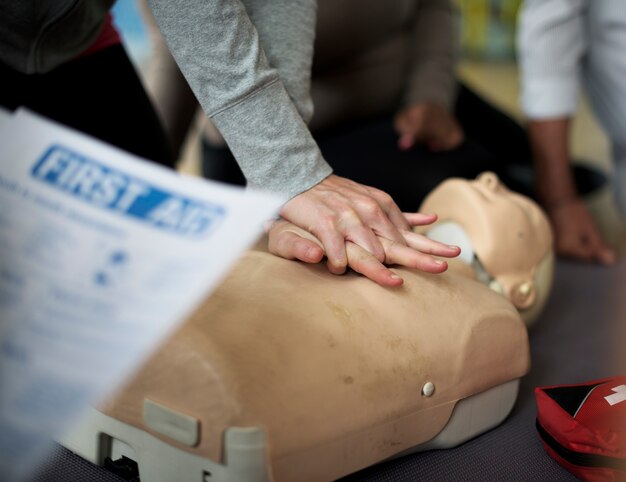
CPR, or Cardiopulmonary Resuscitation, is a life-saving procedure designed to help someone in the event of sudden cardiac arrest. It plays a critical role in emergencies, making it essential for everyone to know its steps to potentially save a life.
If you witness someone experiencing cardiac arrest, your first step is to immediately call for an ambulance from the nearest medical facility. While waiting for professional help, you should begin CPR to restore blood circulation. CPR is a safe procedure with no risk in performing it on someone in need.
Cardiac arrest is a leading cause of death worldwide, surpassing fatalities caused by conditions like lung cancer, strokes, or serious accidents. It occurs when an electrical malfunction in the heart disrupts its ability to pump blood to the brain and other organs. In these moments, every second counts. Starting CPR within 10 minutes of the cardiac arrest and continuing until medical help arrives significantly increases the chance of survival. Delays or slow responses, however, greatly reduce survival odds, often leading to fatal outcomes.
### Steps to Perform CPR:
CPR is an effective first-aid technique that involves chest compressions and rescue breaths to aid someone in cardiac arrest. Here’s how to perform it step by step:
1. **Assess the Situation and Shake the Person:**
If you see someone collapse, check if they’re okay by shaking their shoulders and asking loudly if they can hear you. Repeat a few times to confirm whether they’re conscious. If there’s no response, call for help or alert others nearby.
2. **Check for Normal Breathing:**
Observe whether the person is breathing normally. Look for chest movements, listen for breaths, and feel for air coming from their nose or mouth. If the person isn’t breathing or their breathing is abnormal, proceed to clear their airway by gently tilting their head back and lifting their chin.
3. **Call an Ambulance:**
If breathing is abnormal or absent, call emergency services immediately. Do this before starting CPR to ensure professional help is on its way.
4. **Perform Chest Compressions:**
Kneel next to the person and place the heel of one hand in the center of their chest. Put your other hand on top of the first and weave your fingers together. Keep your arms straight and press down firmly, compressing the chest by 5 to 6 cm. Aim for a compression rate of 100 to 120 per minute. Perform 30 compressions before moving to the next step.
5. **Provide Rescue Breaths:**
After 30 compressions, give two rescue breaths. To do this, tilt the person’s head back, lift their chin, and pinch their nose. Place your mouth over theirs, forming a seal, and blow steadily for about one second, making the chest rise. Repeat for the second breath.
6. **Repeat the Process Until Help Arrives:**
Continue performing 30 compressions followed by two rescue breaths until emergency responders arrive or the person starts showing signs of recovery.
### Important Facts about CPR:
There are several misconceptions about CPR that should be clarified:
– Chest compressions should be performed at a steady rate of 100 to 120 compressions per minute regardless of the victim’s age.
– Checking the victim’s pulse during CPR isn’t necessary and can waste valuable time.
– CPR is still beneficial even if the person is breathing irregularly, as it enhances survival chances.
– If the person remains unconscious while receiving CPR, it doesn’t mean CPR is ineffective—it helps maintain blood flow critical for survival.
– Hands-only CPR (chest compressions without rescue breaths) can be as effective as traditional CPR when performed within the first few minutes of cardiac arrest.
– CPR can sustain the victim’s blood flow for up to an hour until medical professionals take over.
### Causes of Sudden Cardiac Arrest:
Sudden cardiac arrest happens without warning, causing the heart to stop beating and cutting off blood flow to the brain and other critical organs. Common causes include:
– **Coronary Artery Disease:** A blockage in the arteries due to cholesterol buildup can prevent normal blood flow, leading to cardiac arrest.
– **Enlarged Heart:** An enlarged or thickened heart muscle can disrupt normal electrical activity, triggering arrhythmias.
– **Heart Attack:** Scar tissue from a previous heart attack can lead to abnormal heart rhythms.
– **Heart Birth Defects:** Even surgically corrected congenital heart defects can increase the lifelong risk of cardiac arrest.
– **Electrical Problems in the Heart:** Conditions like Long QT Syndrome or Brugada Syndrome affect the heart’s electrical system, causing irregular rhythms.
– **Valvular Heart Issues:** Leaky or narrowed valves can stretch and stress the heart muscle, raising the risk of arrhythmias.
– **Other Factors:** A family history of cardiac arrest, previous heart attacks, or age—especially in men over 45 and women over 55—can all heighten the risk.
Recognizing and addressing sudden cardiac arrest promptly is essential. Learning CPR empowers you to act in life-threatening situations, potentially saving someone’s life when it matters most.